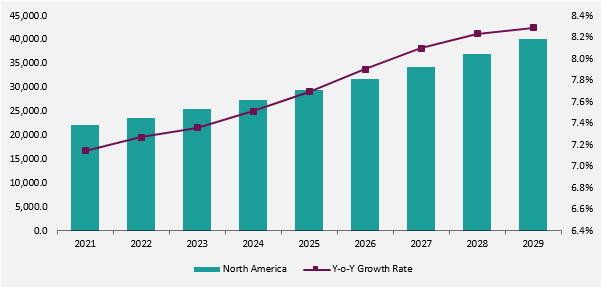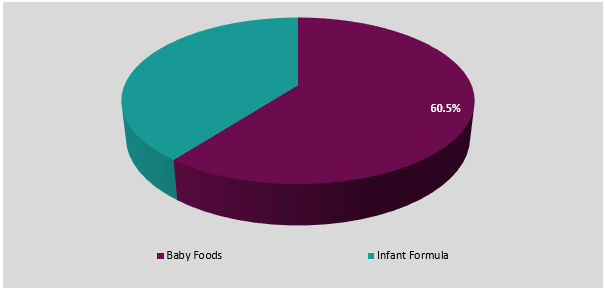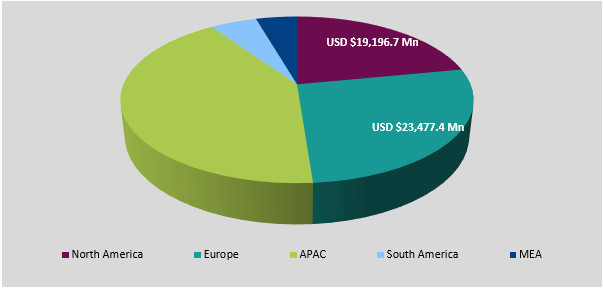Global Baby Food and Infant Formula Market By Type Baby Foods, Milk Formulations, Dried Baby Foods, Prepared Baby Foods, and Others ), By Distribution (Supermarkets/ Hypermarkets Pharmacies Specialty Stores and Others), By Region and Key Companies - Industry Segment Outlook, Market Assessment, Competition Scenario, Trends and Forecast 2020–2030
- Published date: May 2023
- Report ID: 22898
- Number of Pages: 241
- Format:
- keyboard_arrow_up
“Global Baby Food & Infant Formula Market” is the title of an upcoming report offered by Market.US. This comprehensive market research report on the baby food & infant formula industry contains inputs, as well as information & data from both primary and secondary sources, that have been validated and verified by target market experts. Apart from critical data and other related information, the report also includes factors that could be or are potential restraints to market growth, present & future key trends, recourses that can be leveraged for potential market expansion in untapped regions or countries, as well as factors that are presently fueling growth in the baby food & infant formula market. It also covers challenges or threats for new, as well as existing market entrants. The report presents a thorough study of revenues, key developments, strategies, historical data and information by major players that offer crucial perspectives/insights into various market scenarios. The global baby food & infant formula market has been segmented on the basis of product type, distribution channel, as well as regions and countries.
The Global Baby Food & Infant Formula Market was valued at UЅD $94,198.8 Мn in 2020, and is projected to register а САGR of 9.2% over the next 10 years.

Overview:
Infant formula is a manufactured food designed and marketed for feeding infants or babies under the age of 12 months. Baby food is any soft, easily consumed food other than breastmilk that is specifically made for consumption by human babies, usually between the ages of 4 months to 2 years.
Dynamics:
The increasing demand for baby foods & infant formulas owing to the capability of these products to meet the daily nutritional requirements of infants/babies is a primary factor that is expected to boost the revenue growth of the global baby food & infant formula market in the foreseeable future.
The growing strength of the working-class global population due to robust urbanization, especially among women, and the hectic schedules that come with it, is resulting in individuals having lesser time to cater to domestic activities. The convenience of being able to provide ample nutrition to their respective infants is leading more individuals to opt for these products, and is slated to fuel future market growth.
Premium pricing, as well as specific regulations enforced by governing authorities concerning the labelling of these products are factors that may restrain future market growth of this industry. However, the increasing penetration of the internet and smartphones, coupled with the growing prominence of e-tailers and the significant amounts of value-added benefits they offer such as discounts, free home delivery, etc. are factors that are expected to have a positive influence on the revenue growth of the global baby food & infant formulas market in the years to come.
Segmentation of the global baby food & infant formula market is as follows:

On the basis of product type, the baby food segment accounted for the maximum number of revenue shares (60.5%) of the global baby food & infant formula market in 2020, and is slated to index the highest CAGR of 8.9% over the next 10 years. The infant formula segment also made up for considerable revenue shares of this global market in 2020, and is anticipated to continue to do so over the forecast period.

In terms of distribution channel, the hypermarkets/supermarkets segment accounted for the majority revenue shares (43.5%) of the global baby food & infant formula market in 2020, and is slated to register the highest CAGR of 8.9%, with an attractiveness index of 5.4, over the next 10 years. The pharmacies segment is also anticipated to expand at a considerable rate of revenue growth in the coming years.
Regional Segmentation and Analysis:

The markets in the Asia Pacific region accounted for the majority revenue shares of the global baby food & infant formula market in 2020, and is slated to index a CAGR of 8.9% over the next decade. The markets in Europe and North America accounted for the second and third-most number of revenue shares (USD $23,477.4 Mn and $19,196.7 Mn respectively) of this global market in 2020.
Segmentation of the Global Baby Food & Infant Formula Market:
Segmentation by Product Type:
- Baby Foods
- Milk Formulations
- Dried Baby Foods
- Prepared Baby Foods
- Other Baby Foods
- Infant Formula
- Standard Infant Milk
- Follow-on-Milk
- Other Infant Formulas
Segmentation by Distribution Channel:
- Supermarkets/ Hypermarkets
- Pharmacies
- Specialty Stores
- Other Distribution Channels
Segmentation by Region:
- North America
- Europe
- Asia Pacific
- Latin America
- Middle East & Africa
Key players profiled in the market report are:
- Nestlé S.A.
- Abbott Laboratories
- Sofina S.A.
- The Kraft Heinz Co. (H.J. Heinz Company Australia Limited.)
- Reckitt Benckiser Group Plc (Mead Johnson & Company LLC)
- Inner Mongolia Yili Industrial Group Co. Ltd.
- China Mengniu Dairy Co. Ltd. (Bellamy’s Organic)
- Arla Foods A.M.B.A
- The Campbell Soup Co. Brands (Plum Organics)
- Perrigo Co. Plc.
- The Hain Celestial Group Inc.
- Hipp GmbH & Co. Vertrieb KG
For the Baby Food and Infant Formula Market research study, the following years have been considered to estimate the market size:
Attribute Report Details Historical Years
2016-2020
Base Year
2021
Estimated Year
2022
Short Term Projection Year
2028
Projected Year
2023
Long Term Projection Year
2032
Report Coverage
Competitive Landscape, Revenue analysis, Company Share Analysis, Manufacturers Analysis, Volume by Manufacturers, Key Segments, Key company analysis, Market Trends, Distribution Channel, Market Dynamics, COVID-19 Impact Analysis, strategy for existing players to grab maximum market share, and more.
Regional Scope
North America, Europe, Asia-Pacific, South America, Middle East & Africa
Country Scope
United States, Canada and Mexico, Germany, France, UK, Russia and Italy, China, Japan, Korea, India and Southeast Asia, Brazil, Argentina, Colombia etc.Saudi Arabia, UAE, Egypt, Nigeria and South Africa
 Baby Food and Infant Formula MarketPublished date: May 2023add_shopping_cartBuy Now get_appDownload Sample
Baby Food and Infant Formula MarketPublished date: May 2023add_shopping_cartBuy Now get_appDownload Sample - Nestlé S.A Company Profile
- Abbott Laboratories
- Sofina S.A.
- The Kraft Heinz Co. (H.J. Heinz Company Australia Limited.)
- Reckitt Benckiser Group Plc (Mead Johnson & Company LLC)
- Inner Mongolia Yili Industrial Group Co. Ltd.
- China Mengniu Dairy Co. Ltd. (Bellamy's Organic)
- Arla Foods A.M.B.A Company Profile
- The Campbell Soup Co. Brands (Plum Organics)
- Perrigo Co. Plc.
- The Hain Celestial Group Inc.
- Hipp GmbH & Co. Vertrieb KG
- settingsSettings
Our Clients
| Single User $4,599 $3,499 USD / per unit save 24% | Multi User $5,999 $4,299 USD / per unit save 28% | Corporate User $7,299 $4,999 USD / per unit save 32% | |
|---|---|---|---|
| e-Access | |||
| Report Library Access | |||
| Data Set (Excel) | |||
| Company Profile Library Access | |||
| Interactive Dashboard | |||
| Free Custumization | No | up to 10 hrs work | up to 30 hrs work |
| Accessibility | 1 User | 2-5 User | Unlimited |
| Analyst Support | up to 20 hrs | up to 40 hrs | up to 50 hrs |
| Benefit | Up to 20% off on next purchase | Up to 25% off on next purchase | Up to 30% off on next purchase |
| Buy Now ($ 3,499) | Buy Now ($ 4,299) | Buy Now ($ 4,999) |












